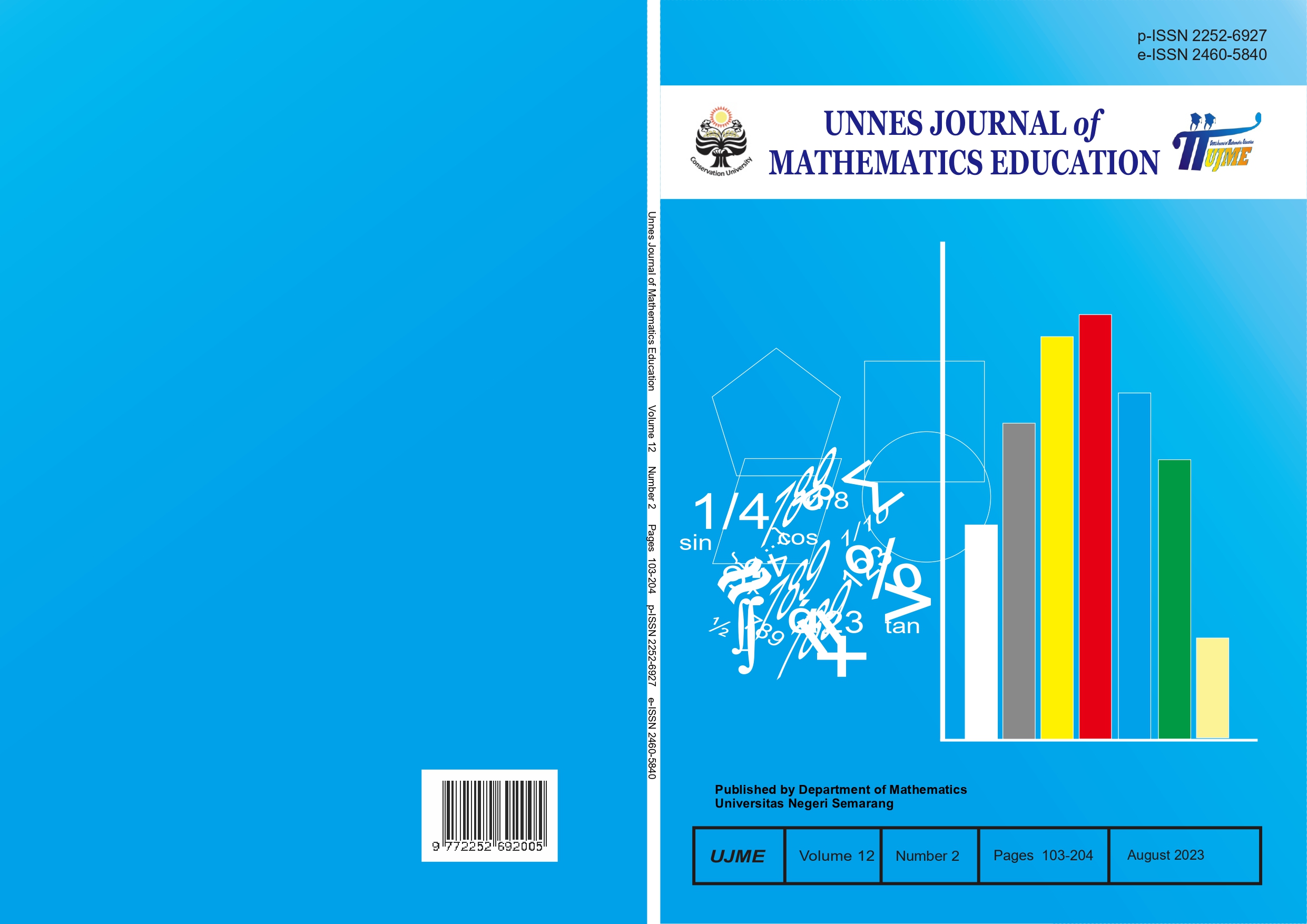Computer Assisted Instruction (CAI) Drill and Practice to Improve Spatial Orientation Ability
##plugins.themes.academic_pro.article.main##
Abstract
This study aimed to examine the quality of improving students' spatial orientation skills through CAI (Computer Assisted Instruction) drill and practice. This study included experiments with the Non-Equivalent Control Group Design involving students at SMPN 18 Bandung selected by teacher, with 29 students in the experimental class and 26 students in the control class. The instrument used was a spatial orientation ability test instrument. The results of this study concluded that (1) the quality of improving the spatial orientation abilities of students who received CAI drill and practice was moderate, and the quality of improving spatial orientation abilities who received conventional learning was low. (2) the increase in the spatial orientation ability of students who get CAI drill and practice is higher than students who get conventional learning.
##plugins.themes.academic_pro.article.details##
References
Cahyani, R.D., Mulyanti Y., & Nurcahyono, N.A. (2020). Analisis Kemampuan Spasial Matematis Siswa dalam Menyelesaikan Soal – Soal Pythagoras. JKPM : Jurnal Kajian Pendidikan Matematika, 6(1), 149-156.
Chang,Y.(2014).3-D CAD Effects on Creative Design Performance of Different Spatial Abilities Students.Journal of Computer Assisted Learning,30,397-407.
Depdiknas. (2006). Permendiknas No. 22 Tahun 2006 Tentang Standar Isi. Jakarta : Depdiknas.
Hake, R, R. (1999). Analyzing Change/Gain Scores. AREA-D American Education Research Association’s Devision.D, Measurement and Reasearch Methodology.
Heinich, R. et al. (2002). Instructional Media and Technology for Learning, 7th edition. New Jersey: Prentice Hall, Inc.
Lestari & Yudhanegara. (2015). Penelitian Pendidikan Matematika. Bandung : PT Refika Aditama.
Lutfi, M.K. & Jupri, A. (2020). Analysis of Junior High School Student’s Spatial Ability Based on Van Hiele’s Level of Thinking for The Topic of Triangle Similarity. Journal of Physics : Conference Series, 1521(3), 26-32
Maier, P. H. (1998)."Spatial Geometry and Spatial Ability - How to make solid Geometry solid". Dalam Annual Conference of Didactics of Mathematics 1996.63-75. Osnabrueck: University of Osnabrueck
McGee, M.G. (1979).Human Spatial Abililities : Psychometric Studies and Enviromental, Genetic Hormonal, and Neurological Influences. Psychological Bulletin, 86(5), 889-918.
Millard, H.A.T.(2014). Relationships Among Video Gaming Proficiency and Spatial Orientation, Laparosopic, and Traditional Surgical Skills of Third-Year Veterinary Students.Journal of the America Veterinary Medical Association,244(3),357-362.
NCTM. (2000). Principle and Standards with The Learing From Assesment Materials.Virginia: NCTM. Inc.
Nurjanah, Latif, B., Yuliardi, R., & Tamur, M.(2020). Computer Assisted Learning Using the Cabri 3D for Imporving Spacial Ability and Self Regulated Learning. Helyion, 6(11),1-7.
Nurjanah, Dahlan, J.A., & Wibisono, Y.(2021). The Effect of Hands-On and Computer-Based Learning Activity on Conceptual Undertanding and Mathematical Reasoni. International Journal of Instruction, 14(1), 143-160.
Onasanya, S. A., Daramola, F. O., & Asuquo, E. N. (2006). Effect of Computer Assisted Instructional Package on Secondary School Students Achievement in Introductory Technology in Ilorin, Nigerian. The Nigeria Journal of Educational Media and Technology, 12(1), 98-107.
Picciano, A.G. (2010). Educational Leadership and Planning for Technology, 5th edition. New York: Pearson.
Priyanda, R.(2019). Efektivitas Penggunaan Media Pembelajaran Matematika Menggunakan Media CAI dengan Tipe Tutorial Terhadap Hasil Belajar Siswa SMK Muhammadiyah 9 Medan. Jurnal Dimensi Matematika, 2(1), 50-57.
Riastuti, N., Mardiyana, M., & Pramudya, I.F. (2017). Students’ Error in Geometry Viewed from Spatial Intelligence . Journal of Physics : Conference Series, 895.
Rohimah, I., & Nursupianah, I. (2016). Pengaruh Pemahaman Konsep Geometri Terhadap Kemampuan Siswa dalam Menyelesaikan Soal – Soal Bidang Datar (Studi Kasus Kelas VII di SMP Negeri 1 Cidahu Kabupaten Kuningan). Eduma: Mathematics Education Learning and Teaching, 5(1), 20-35.
Safrina, Ikhasan, & Ahmad. (2014). Peningkatan Kemampuan Pemecahan Masalah Geometri melalui Pembelajaran Kooperatif Berbasis Teori Van Hiele. Jurnal Didaktik,1 (1), 9-20.
Senel, H.C. (2019) . Comparing the Effect of Tablet, Desktop, Paper-Pencil Based Drill Practices on Spatial Skill of Vocational High School Students. (Tesis). Computer Education and Instructional Technology Departement, Middle East Technical University, Turki.
Suardipa, I P. (2020). Sociocultural-Revolution Ala Vygotsky dalam Konteks Pembelajaran. Widya Kumara Jurnal Pendidikan Anak Usia Dini,1(2), 48-58.
Sudirman, S. & Alghadari, F. (2020). Bagaimana Mengembangkan Kemampuan Spatial dalam Pembelajaran di Sekolah ?: Suatu Tinjauan Literatur. Journal Instructional Mathematics, 1(2), 60-72.
Walle, J. A. V.D. (1994). Elementary School Mathematics. New York : Longman.
Wulansari, A. N. (2019). Analisis Kemampuan Spasial Matematis Siswa dalam Menyelesaikan Masalah Matematika. Prosiding Seminar Nasional Matematika dan Pendidikan Matematika, 504-513.
Yuliardi, R. (2015). Implementasi Pembelajaran Berbasis Komputer Tipe Drill Terhadap Peningkatan Kemampuan Spatial Sense Siswa SMP Negeri 2 Kadugede.JUMLAHKU: Jurnal Matematika Ilmiah STKIP Muhammadiyah Kuningan, 1(1).
Yuliardi, R. (2017). Pembelajaran Matematika Berbantuan Software Geogebra untuk Meningkatkan Kemampuan Spatial dan Komunikasi Matematis Siswa SMK. Unnes Journal of Mathematic Education, 6(1), 121-127.
